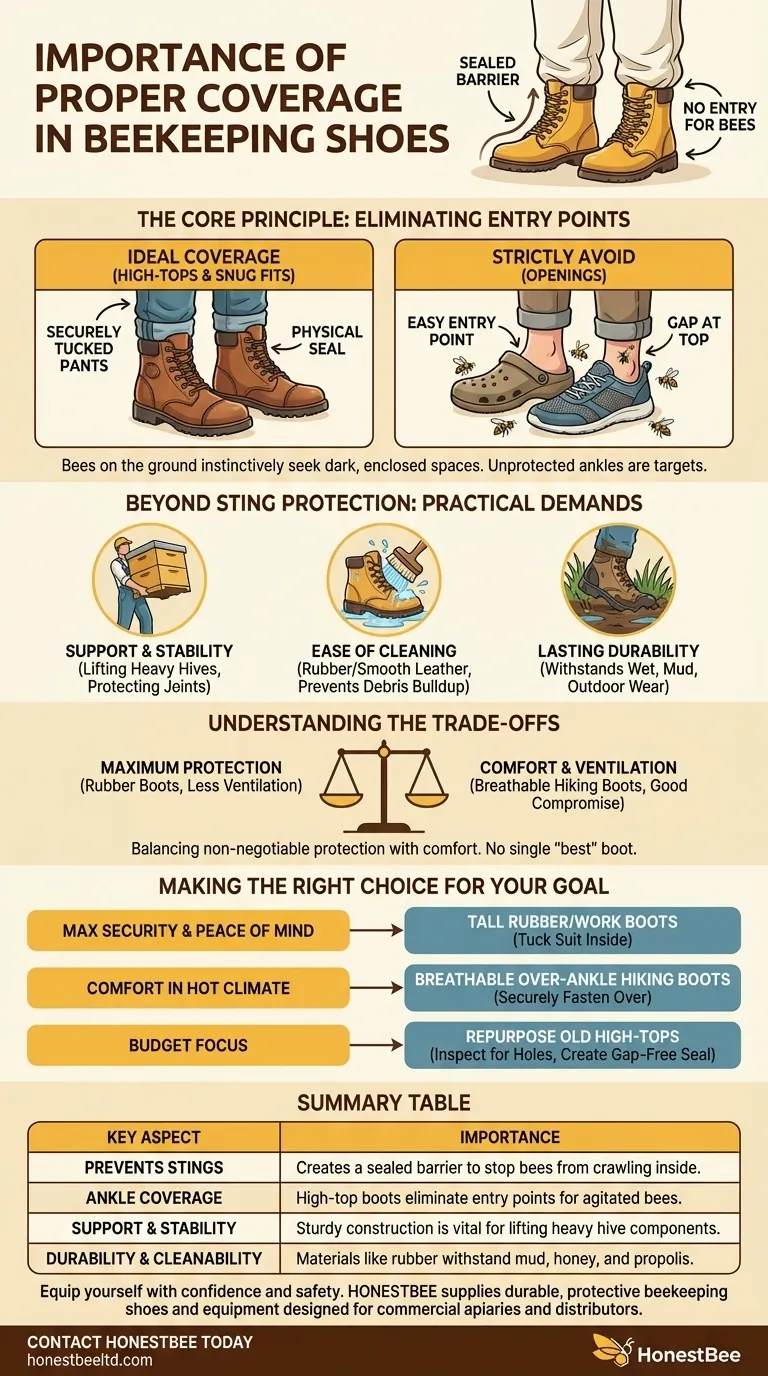To be direct, proper coverage in beekeeping shoes is essential for one critical reason: to prevent bees from crawling inside your footwear and stinging your feet and ankles. During a hive inspection, bees can be dislodged and fall to the ground, where they will instinctively seek the nearest dark, enclosed space. An unprotected ankle or a gap between your pants and shoes presents an easy entry point.
The goal of beekeeping footwear isn't about a specific brand or style, but about creating an unbroken, sealed barrier from your toes to your lower leg. This protection is the foundation upon which other important factors like comfort and support are built.

The Core Principle: Eliminating Entry Points
The most fundamental job of your beekeeping gear is to serve as a complete line of defense. Your footwear is the anchor of this system, and any failure here compromises the entire setup.
Why Bees Target Feet and Ankles
Bees that are agitated or accidentally knocked off a hive frame often end up on the ground. From there, their instinct is to crawl upwards and find shelter. The gap at the top of a low-cut shoe is an obvious and inviting target.
The Ideal Coverage: High-Tops and Snug Fits
The most effective footwear consists of high-top boots or shoes that extend over the ankle. This design allows you to securely tuck your beekeeping suit or pant legs into the boots, creating a physical seal that bees cannot penetrate.
What to Strictly Avoid
Any footwear with openings is unsuitable for the bee yard. Shoes like clogs (Crocs), sandals, or mesh sneakers offer virtually no protection. Bees can easily enter through holes or sting directly through thin mesh material.
Beyond Sting Protection: Practical Demands of the Bee Yard
While preventing stings is the primary concern, effective beekeeping footwear must also meet the practical demands of the job, which is often physically taxing.
The Need for Support
Beekeeping involves lifting heavy hive components, such as honey supers, which can weigh over 50 pounds. Shoes with sturdy construction and supportive insoles are crucial for protecting your back and joints and providing stability on uneven ground.
Ease of Cleaning
Bee yards are often muddy and can become sticky with honey, beeswax, and propolis. Footwear made from materials like rubber or smooth leather is far easier to clean with a brush and water, preventing the buildup of debris and maintaining better hygiene.
Lasting Durability
Your shoes will be exposed to wet grass, mud, and the general wear and tear of outdoor work. Investing in durable footwear ensures it will last for many seasons and won't fail unexpectedly, exposing you to risk.
Understanding the Trade-offs
Choosing the perfect shoe involves balancing non-negotiable protection with comfort. There is no single "best" boot for everyone.
Coverage vs. Ventilation
The most protective footwear, like tall rubber boots, often offers the least ventilation. In hot climates, this can lead to discomfort. Finding a balance is key.
Many beekeepers opt for breathable leather or synthetic hiking boots that still provide ankle coverage. This offers a good compromise between sting protection and keeping your feet cool and dry.
Dedicated Gear vs. Repurposed Shoes
Using old sneakers can seem cost-effective, but they often lack the ankle coverage, support, and durability needed. A dedicated pair of boots is an investment in your safety and comfort that pays off over time.
Making the Right Choice for Your Goal
Your final decision should be guided by your priorities, budget, and local climate.
- If your primary focus is maximum security and peace of mind: Choose tall rubber boots or leather work boots that allow you to securely tuck your bee suit inside.
- If your primary focus is comfort in a hot climate: Select breathable, over-the-ankle hiking boots and ensure your pant legs can be securely fastened over them without gaps.
- If your primary focus is budget: Repurpose a pair of old high-top work boots or sneakers, but first inspect them meticulously for any holes and confirm you can create a gap-free seal with your pants.
Your footwear is the foundation of your confidence and safety in the bee yard; choose it with intention.
Summary Table:
| Key Aspect | Importance |
|---|---|
| Prevents Stings | Creates a sealed barrier to stop bees from crawling inside footwear. |
| Ankle Coverage | High-top boots eliminate entry points for agitated bees on the ground. |
| Support & Stability | Sturdy construction is vital for lifting heavy hive components safely. |
| Durability & Cleanability | Materials like rubber withstand mud, honey, and propolis for long-term use. |
Equip yourself with confidence and safety. The right footwear is the foundation of effective beekeeping. HONESTBEE supplies durable, protective beekeeping shoes and equipment designed for the demands of commercial apiaries and distributors. Our wholesale-focused operations ensure you get the reliable gear you need.
Contact HONESTBEE today to discuss your beekeeping supply needs and discover how we can support your operation.
Visual Guide

Related Products
- Cotton Beekeeping Suit and Round Hat with Veil Bee Keeper Protective Gear
- Professional Beekeeping Suit for Kids and Girls Childrens Bee Keeper Suit
- White Beekeeping Protective Suit and Hat with Fencing Veil for Beekeepers
- Mesh Ventilated 3 Layer Goatskin Beekeepers Gloves for Beekeeping
- Beekeeper Cowboy Hat and Veil for Beekeeping
People Also Ask
- What factors should be considered when choosing a beekeeping suit? Balance Safety, Comfort & Performance
- What should be considered regarding the color of beekeeping clothing? Ensure Your Safety and Keep Bees Calm
- Why is a jacket with a hat veil recommended for beekeepers? Essential Protection for Your Face and Neck
- What are the benefits of a fully ventilated beekeeping suit? Stay Cool and Protected in Hot Climates
- How should a bee suit be cleaned? Protect Your Investment and Ensure Apiary Safety



















